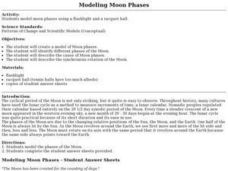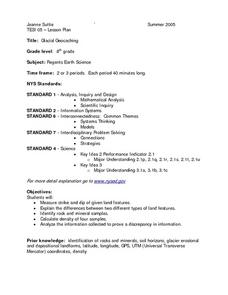Curated OER
Create a Cat with Amaco Scuptamold and Wireform Metal Mesh
Learners create an animal from Sculptamold and metal mesh. In this hands-on arts lesson, students use the materials provided the create a piece of art in the form of an animal. This lesson includes easy step-by-step directions.
Curated OER
Modeling Moon Phases
Learners identify the phases of the Moon and the synchronous rotation. In this hands on lesson students will create a model of the Moon.
Curated OER
Exact or Estimation
Students solve problems using estimation and exact calculations. In this algebra lesson, students use gum balls and thread to create hands on manipulatives to solve problems. They calculate the average of their total data.
Curated OER
Edible Soil
Students model the soils layers using Oreo's. In this lesson students use their favorite food items to create a model of soil layers. A discovery lesson from a youth camp is adapted for classroom modeling and discussion of soil ecology....
Curated OER
Emotional Speed with Balls and Ramps
Fifth graders investigate the relationship between mass and speed. In this physics lesson, 5th graders experiment with motion by being given a ramp, two balls, and blocks or books for elevation. Students determine how different variables...
Curated OER
Science: Gravity, Mass, and Weight
Third graders discover the interrelationship between weight, mass, and gravity by conducting several simple experiments. After individually weighing objects, they graph the weights on worksheets. Extensions include making flip books...
Curated OER
Where Is Japan? How Far Is That?
First graders use literature and hands-on activities with maps and globes to explain distance and tools used to measure distance. They select tools to measure various objects in the classroom, then apply those concepts to their map...
Curated OER
Shape Makes a Difference!
Learners learn the difference between perimeter and area by watching a video and a hands on activity.
Curated OER
How Tall Is It?
First graders practice measuring different items with different units of measurement. They move from station to station measuring items. They complete a worksheet as they go.
Curated OER
Glacial Geocaching
Eighth graders measure strike and dip of given land features and explain the difference between them. They also look at rock and mineral samples for indentification, along with calculating the density. Finally, information is analyzed...
Curated OER
Weather Instrument Use and Application
Eighth graders measure temperature, wind speed and pressure using Skymaster SM-28. In this earth science lesson, 8th graders collect data and record observations taken from outdoors. They explain why numerical values are different in...
Curated OER
Classroom Triangles
Students use bearing measurements to triangulate and determine objects' locations. Working in teams of two or three, students must put on their investigative hats as they take bearing measurements to specified landmarks in their...
Curated OER
"Use an Anemometer," said the Meteorologist
Pupils work in groups to make an instrument the Meteorologists use to measure the speed of the wind after the teacher reads them a poem about the wind. Students then review vocabulary that they studied from their lesson.
Curated OER
Ready to Erupt!
Students observe a visual representation of a volcano erupting. They measure and sketch the volcano and discuss how engineers use this information. They discover the type of equipment used to indicate an eruption.
Curated OER
GET THE POINT!
The student will measure the width of the horns on drawings of longhorn cattle and then convert the measurements from inches to centimeters and from inches to feet.1. Review with students the steps required to measure an item and to...
Curated OER
Sliding and Stuttering
Students measure frictional force existing between a moving cup and the surface it slides on. They conduct the experiment and answer discussion questions.
Curated OER
Using the Microscope
High schoolers demonstrate their ability to properly make observations using a compound microscope. They prepare an onion skin slide and focus on it in both low and high power. Then they measure the diameter of one of the cells.
Curated OER
Launching Rockets
Second graders discuss experiences of watching a rocket launch either on television or in person before making paper rockets. They make and color rockets which they attempt to launch using a strong breath blown through a straw at the...
Curated OER
Angles: Angles, Angles, Everywhere
Students estimate and accurately measure the size of angles communicate with the appropriate geometric terms and symbols to describe and name angles, lines, line segments, rays
Curated OER
Hey, Look Me Over!
Students make observations about mealworms using hand lenses, rulers, and cotton swabs. Students complete their own mealworm observation chart, then they share their observations with the class. This is one station out of five in an...
Curated OER
The Breathtaking Nature of the Urban Explosion, Part 2
Learners explore ozone levels. They measure the concentrations of ground-level ozone in the atmosphere. Students observe changes in the concentrations of ozone over time. Learners complete a data sheet to record ozone readings over a...
Curated OER
Compare Your Air
Students will compare the data for different locations that they select and investigate trends over the course of a number of years. This will give the students an opportunity to apply statistical measures (mean, median,mode) to data...
Curated OER
Snow vs. Water
Students fill three cups with snow. They record the height of snow in each cup, and allow the snow to melt. Students measure the height of the water in each glass or cup, and record their results on the worksheet. They answer questions...
Curated OER
Sleuth Rays
Students conduct a close examination of the atom's electrons, and discover how to theorize the energy levels, observe the brightness of light, classify colors, and measure temperature.

























